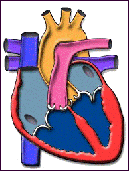Intensive
Cardiovascular Intervention Lowers Blood Lipids in HIV Patients on Antiretroviral
Therapy
 | An
intensive cardiovascular risk-reduction program lowered LDL cholesterol in HIV
patients on HAART, though it did not lead to reduced levels of inflammatory biomarkers
or carotid intima-media thickness, according to a study presented at the 5th International
AIDS Society Conference on HIV Pathogenesis, Treatment, and Prevention this week
in Cape Town, South Africa. |
By
Liz Highleyman  Most
studies indicate that people with HIV have an elevated risk of cardiovascular
disease compared with the general population, but the interplay of HIV infection
itself, antiretroviral therapy
(ART), and traditional risk factors is not fully understood. Preventive measures
should be tailored to individual patients, but how best to manage cardiovascular
risk in HIV positive people is not well-defined. Most
studies indicate that people with HIV have an elevated risk of cardiovascular
disease compared with the general population, but the interplay of HIV infection
itself, antiretroviral therapy
(ART), and traditional risk factors is not fully understood. Preventive measures
should be tailored to individual patients, but how best to manage cardiovascular
risk in HIV positive people is not well-defined.
Spanish
researchers designed a study to evaluate the effectiveness and safety of an intensive
cardiovascular risk reduction intervention versus a standard-of-care intervention
in HIV patients with moderate-to-high cardiovascular risk. This
small pilot study included 68 participants with stable viral suppression on ART.
About 90% were men and the average age was about 50 years. About 40% were taking
protease inhibitor (PI)-based regimens and nearly two-thirds were smokers. Participants
had 2 or more cardiovascular risk factors or a Framingham risk score of 10% or
higher (mean of about 15%) and had a low-density lipoprotein (LDL or "bad")
cholesterol level of 100 mg/dl or higher. At baseline, about half had plaques
an indicator of atherosclerosis, or "hardening of the arteries" in the
carotid arteries in the neck. Participants
were randomly assigned to the 2 study arms. Those receiving the standard-of-care
intervention attempted to reduce LDL cholesterol below 130 mg/dl. Those in the
intensive intervention group took steps to push LDL below 100 mg/dl, including:  | Taking
the lipid-lowering drug atorvastatin starting at 10 or 20 mg. |  | Adding
ezetimibe if the LDL goal was not attained after doubling the dose of atorvastatin. |  | Using
anti-platelet therapy (aspirin or clopidogrel) to reduce coagulation. |  | Strong
encouragement to quit smoking. |  | Switching
form other boosted PIs to atazanavir (boosted or unboosted), which had less effect
on lipids than other drugs in its class. |  | Attempting
to reach standard blood pressure and glycemic goals. |
The
primary study endpoint was progression of atherosclerosis, measured by changes
in carotid intima-media thickness (cIMT), an indicator of plaque build-up in the
carotid arteries. Secondary endpoints were achievement of LDL target levels, changes
in levels of blood biomarkers associated with inflammation (including C-reactive
protein, interleukin-6, and TNF-alpha), safety, and feasibility. Results  | After
12 months, the median proportional change in cIMT was +1.63% in the intensive
intervention arm compared with +1.79% in the standard intervention arm, not a
statistically significant difference (P = 0.59). |  | LDL
cholesterol fell from 141 to 88 mg/dl in the intensive intervention arm, while
remaining stable (131 to 126 mg/dl) in the standard intervention arm (P < 0.001). |  | 60%
of participants in the intensive intervention arm reached the LDL target level. |  | Levels
of triglyceride and high-density lipoprotein (HDL or "good") cholesterol
did not change significantly. |  | Framingham
risk scores did not decrease significantly in either group. |  | Interleukin-6
levels fell more in the standard intervention group (-25.4 vs -7.2 pg/ml) while
TNF-alpha fell more in the intensive intervention arm (-42.5 vs -11.7 pg/ml),
but these differences were not statistically significant. |  | C-reactive
protein fell in the intensive intervention arm while rising in the standard intervention
arm (-1.4 vs +6/2 mg/l), with a trend toward statistical significance (P = 0.08). |  | A
number of patients attempted to stop smoking, but only 1 remained abstinent at
the end of the study. |  | Viral
load remained suppressed and CD4 cell counts remained stable. |  | No
significant adverse events were reported in either group during the follow-up
period. |
"An
aggressive pharmacologic intervention on cardiovascular risk factors is feasible,
safe, and effective in controlling LDL [cholesterol]," the investigators
concluded. "However, the intervention did not influence cIMT progression
nor inflammatory biomarkers after one year of follow-up." The
investigators have collected longer-term data through 3 years, which they are
currently in the process of analyzing. Session
moderator Esteban Martinez noted that this type of study is needed to inform cardiovascular
risk management guidelines for people with HIV, and expressed hope that some benefits
might be seen with longer follow-up. Hospital
General Universitario de Elche, Unit Infectious Diseases and Clinical Laboratory
Analysis, Alicante, Spain; Hospital Clinic-IDIBAPS, Barcelona, Spain. 7/24/09 Reference
M
Masiá, E Bernal, S Padilla, and others. A randomized trial comparing an
intensive versus a standard intervention in stable HIV-infected patients with
moderate-high cardiovascular risk. 5th International AIDS Society Conference on
HIV Pathogenesis, Treatment, and Prevention (IAS 2009). July 19-22, 2009. Cape
Town, South Africa. Abstract TuAb201.
|
|